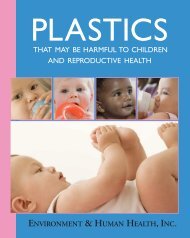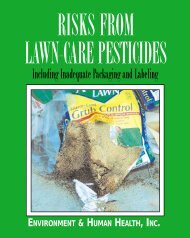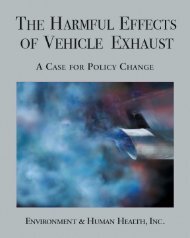LEED Report - Environment & Human Health, Inc.
LEED Report - Environment & Human Health, Inc.
LEED Report - Environment & Human Health, Inc.
- No tags were found...
You also want an ePaper? Increase the reach of your titles
YUMPU automatically turns print PDFs into web optimized ePapers that Google loves.
The Green Building DebateP e s t i c i d e sThe <strong>LEED</strong> certification for the existing building rating system does notrequire pesticide use reduction. Instead it offers 1 possible credit withinthe <strong>LEED</strong> “Sustainable Sites” category for developing an “Integrated PestManagement (IPM), Erosion Control and Landscape Management Plan”;and 1 additional possible credit in its “Green Cleaning-Integrated PestManagement” category. Thus, only 2 credits are possible in categoriesthat have multiple additional objectives. It is possible to neglect pesticidestotally and still receive the highest “platinum” level of certification.Pesticides are deliberately toxic substances and more than 100 millionpounds are released indoors in the United States each year. EPA haslicensed nearly 107 separate pesticides for use in indoor settings. Theagency has rarely requested experimental data on indoor chemicalpersistence, movement, or human exposures, before issuing permits tomanufacturers. Rather than requiring these studies, EPA scientistsinferred risks from data developed and submitted by manufacturers tosupport licenses for outdoor uses.Pesti cides are intentional additives to many consumer products, such ascloth ing, carpets, plastics, paints, stains, building materials, playequipment, furniture, some detergents, fuels, shampoos, pet products,cosmetics and pharmaceuticals—all of which end up within indoorenvironments.It is possible to neglectpesticides totally andstill receive the highest“platinum” level ofcertification.... There is nolegal requirement to informoccupants about thechemicals that have beenapplied, their potentialhealth effects, or theirrate of dissipation.Americans spend more than 90 percent of their time inside build ings.Pesticides released indoors can produce extended exposures, especiallyif indoor areas are poorly ventilated. There is no legal requirement toinform occupants about the chemicals that have been applied, theirpotential health effects, or their rate of dissipation, all of which arenecessary to know in order to determine when it is safe to re-enter thestructure following treatment.23







